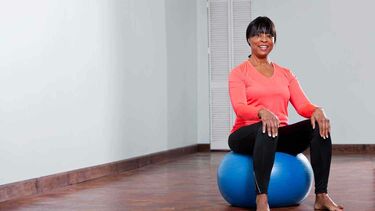
Training your pelvic floor muscles throughout life can reduce your risk of prolapse.
By Muriel Reddy
Every woman is at risk of pelvic organ prolapse, yet most of us find it too embarrassing to talk about. “It’s about the genital area and it’s private,” explains Jean Hailes urogynaecologist Dr Payam Nikpoor.
Prolapse happens when the muscles supporting a woman’s pelvic organs – the bladder, uterus and bowel – weaken and cause one or more of those organs to drop. Women often report the feeling of a bulge or a pressure in the vagina; like a feeling that they are sitting on an orange or a tennis ball. Sometimes they will notice tissue sticking out of the vagina.
Two of the more common symptoms of prolapse are the leaking of urine (wee) or faeces (poo), known as urinary and faecal incontinence.
The Continence Foundation of Australia estimates that one in four people in Australia are incontinent, meaning they have trouble controlling their bladder and/or bowel.
Some women can experience urinary problems such as slow stream, a feeling that they are not completely emptying the bladder. Others suffer from urgency and stress urinary incontinence. Bowel problems can develop when women suffer from constipation, or a feeling of not fully emptying the bowel.
For women who experience prolapse, it will usually occur after menopause, from the ages of the mid-50s through to the 70s. “However, what we know is that childbirth is a risk factor,” says Dr Nikpoor. “So too is constipation, obesity, people who have chronic raised intra- abdominal pressure [straining], and chronic cough.” Ageing and a family history of prolapse are also risk factors.
Women with prolapse can experience pain during sexual intercourse. Others report a lack of sensation during intercourse.
Not all women with bulge will need surgery, but they will need to see a physiotherapist and learn pelvic floor exercises, and may need to make healthier lifestyle changes.
Early intervention is key in the treatment of pelvic floor prolapse, says Jean Hailes pelvic floor physiotherapist Janetta Webb. “It’s important for women to talk to their GP if there’s any change to their bladder or bowel function,” she explains. “Undergoing a pelvic floor training program and adopting some lifestyle advice can reduce or eliminate symptoms.”
Ms Webb believes it is helpful for women to train their pelvic floor muscles throughout all the stages of their lives – after childbirth, at menopause and in the later years – even if they do not have issues. Women who do experience prolapse will need a tailored intensive pelvic floor program. This has been shown to reduce symptoms. They will also be given correct techniques for bladder and bowel emptying.
Ms Webb says many women fear they will be unable to return to the sorts of physical activities they have always enjoyed, but this is not necessarily true.
Undergoing a pelvic floor training program and adopting some lifestyle advice can reduce or eliminate symptoms.”
Jean Hailes pelvic floor physiotherapist Janetta Webb
“There’s a device that has been developed that allows women to continue with regular forms of exercise while monitoring its impact on their pelvic floor,” she explains. “It’s inserted into the vagina and has a little Bluetooth monitor that tucks into your undies.
“It’s suitable for anyone who wants to train [their] pelvic floor and monitor what’s happening during exercise.”
Making lifestyle changes can lower risk factors of prolapse. Dr Nikpoor says these include eating healthily, exercising regularly, keeping a normal weight, and avoiding constipation. This lifestyle approach, along with pelvic floor muscle exercise, is the conservative approach to treatment. If this doesn’t work, health professionals will consider the next steps in management.
Dr Nikpoor says he always considers the use of vaginal pessaries – supportive devices that hold the prolapsed organ in place – before surgery.
Neither uncomfortable nor painful, pessaries come in a range of shapes and sizes to suit the type and degree of prolapse. Once inserted, they require regular monitoring.
“They can be managed either by a pelvic floor physiotherapist, a continence nurse or a gynaecologist,” Dr Nikpoor says.
“They can stay for as long as they are effective – for the rest of their lives if they work.
Surgery is considered the last management option. “This involves procedures that would reinforce the supporting tissue in the pelvis to rectify the prolapse,” says Dr Nikpoor.
3 THINGS TO KNOW
HOW TO STRENGTHEN YOUR PELVIC FLOOR
Start practising this exercise daily, either sitting or lying down on your back with your knees bent and feet flat. This is easiest on your bed or couch.
Tighten
Level 1
Level 2
Please note, if you have an issue with vaginal or pelvic pain, you will need a special program from a pelvic floor physiotherapist before proceeding any further.
Level 3
After you have done 10 of the level 2 exercise, do some really strong squeezes – as strong as you can, then let go.
Do as many of these as you can, up to about 10.
All reasonable steps have been taken to ensure the information created by Jean Hailes Foundation, and published on this website is accurate as at the time of its creation.
© 2024 Jean Hailes Foundation. All rights reserved. This publication may not be reproduced in whole or in part by any means without written permission of the copyright owner. Contact: licensing@jeanhailes.org.au